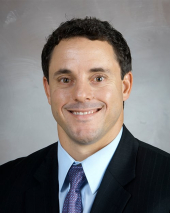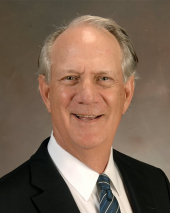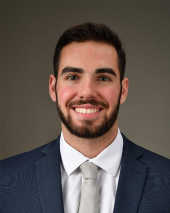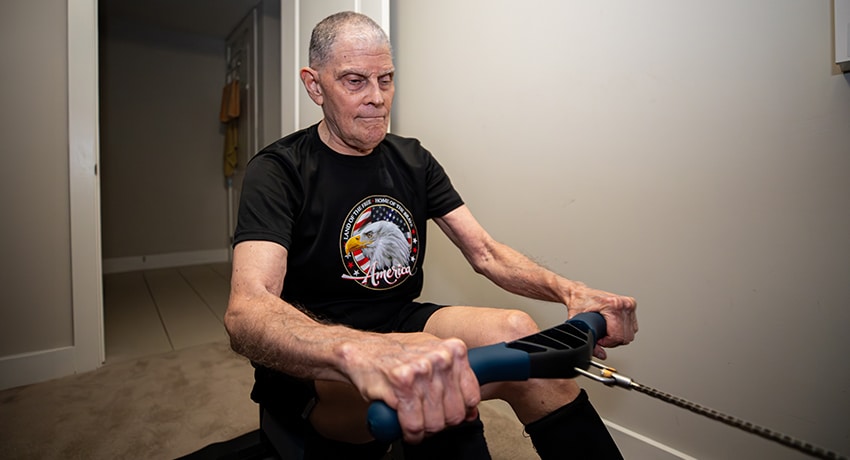When asked to describe his lifestyle, Reuben Bronstein, age 79, uses the words “extremely physically active” for the last 40+ years. He was a serious marathon runner until stress fractures in his tibia sidelined him. Exercising on the elliptical and treadmill were not replacement options he enjoyed. Then he bought a rower, and it became his second love to running for the past 13 years.
“I’m an intense rower, meaning my minimum goal is to row two marathons a week – 50 or so miles,” Reuben said.
Following these passions has translated to many injuries and related surgeries. Reuben’s shoulders were affected in the process, due to falls in the street and other major impact. He previously had a rotator cuff repair on his left shoulder years ago. Reuben wasn’t interested in getting shoulder replacements, he said, until they could guarantee to last 20 or 25 years because he was so active.
Path to healing

Reuben found Robert Fullick, MD, orthopedic surgeon with UT Physicians, to navigate a new path for his shoulders. Fullick discovered Reuben had arthritis in both of his shoulders, and tendons in his rotator cuff were badly torn.
“The instability in his shoulder joints became painful and disabling, and it affected his quality of life,” said Fullick, assistant professor in the Department of Orthopedic Surgery at McGovern Medical School at UTHealth Houston. “He could still row, because that’s below shoulder level, but everything was becoming more and more painful.”
Fullick recommended Reuben begin with guided cortisone injections in radiology and physical therapy. When that didn’t contribute a successful outcome, shoulder replacements were the next step. Double shoulder replacement is actually extremely common, Fullick said, when trauma isn’t involved in one of the shoulders.
“The beauty of Reuben’s case is his motion was relatively good because he has always maintained a high level of activity,” Fullick said. “Strength was not as good because of the damage.”
Fullick performed a reverse shoulder replacement on Reuben’s right shoulder in September 2019. A reverse replacement has a metal ball with a plastic socket that sits on a stem going down the humerus bone. A standard shoulder replacement (anatomic ball and socket) was not an option due to the damage to Reuben’s rotator cuff. Nearly four months later, Fullick did the same procedure on Reuben’s left shoulder, while he was still working to strengthen the first one in physical therapy.
“I knew Reuben wanted full range of motion and was going to put significant mileage on these implants, so I had to be very particular about how I did the procedure to maximize motion,” Fullick said. “That’s different than a sedentary individual who is looking for pain relief and the ability to sleep.”
Therapy for a successful outcome

Reuben’s philosophy is to get with the right physical therapist and do therapy exercises at home.
“Anyone who knows me knows I want to be the best I can be,” Reuben said. “I don’t care if I was close to 76 at the time of surgery. I don’t want to be somebody who can’t be active. I told them in therapy to treat me like a 25-year-old athlete.”
Reuben completed physical therapy at UT Physicians Physical Therapy at Texas Medical Center with Russell Paine, PT, and Christopher Gallina, PT. After his first shoulder replacement, he spent three months doing rehabilitation. He planned to do the same with the second shoulder, but COVID-19 affected the clinic operations. At that point, he got equipment and rehabbed both of his shoulders at home.

By June, Reuben was starting to row a little, and he was back to full strength in September, rowing around 15,000 meters a day. He said he works out about four hours a day, at least five days a week. Reuben attributes his successful recovery to continuing to do everything he learned at therapy at home as part of his routine after he rows. This includes using the pulley on the wall and light weights to keep his shoulders loose. He believes if people don’t rehab well, they won’t have a great outcome.
Mutual praise
Fullick said there are instances where someone can almost work too hard after shoulder replacement surgeries. At times, they had to dial Reuben back, but he was always accommodating.
“Reuben was a great patient from Day 1,” Fullick said. “He did exactly what I asked of him and stayed on the rehab protocol.”
Reuben has strong appreciation for Fullick and his shoulder replacements.
“I think the world of Dr. Fullick,” Reuben said. “He’s the best shoulder guy you’ll find anywhere.”
He also expresses much gratitude for his wife, who has spent half of their married life with him while he has done rehabbing from surgeries. He doesn’t know what he would have done without her.
He laughs that his shoulder replacements will probably last 25 years – until he’s 101 years old!



